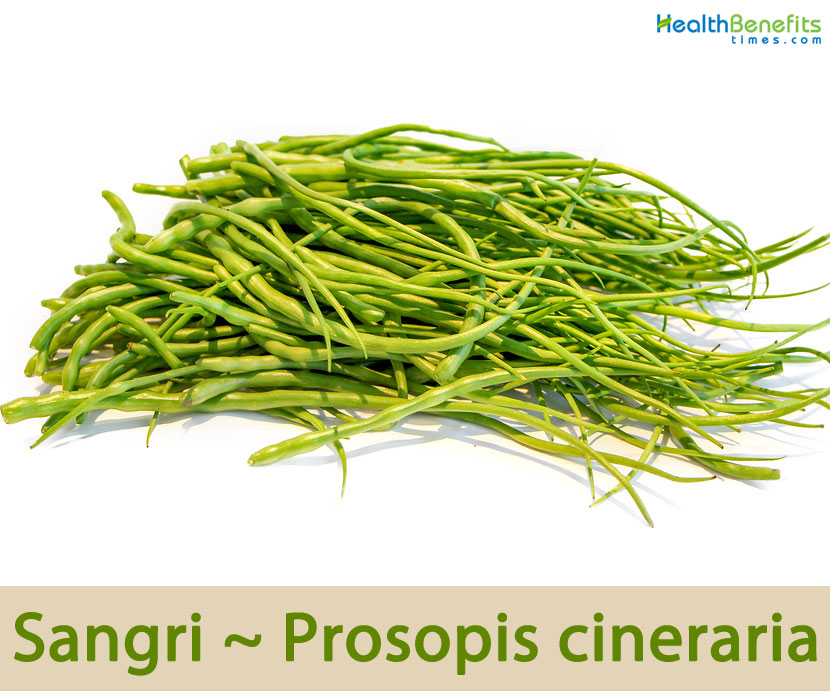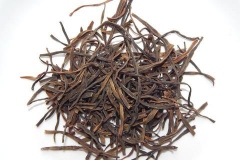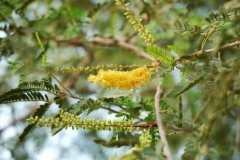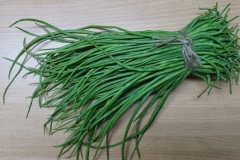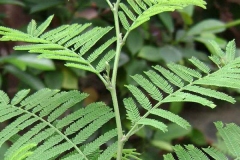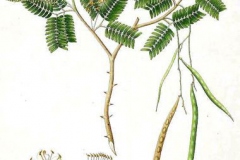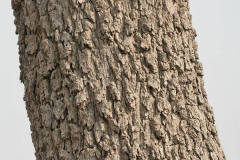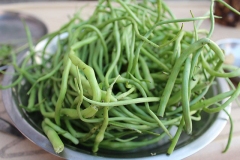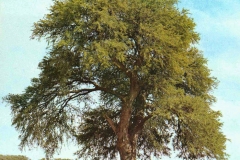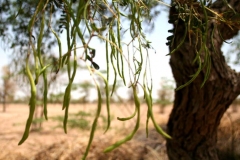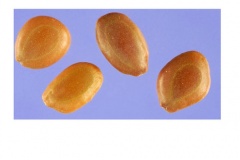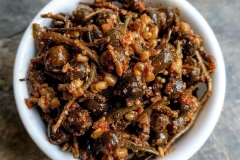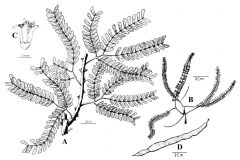| Sangri Quick Facts | ||
|---|---|---|
| Name: | Sangri | |
| Scientific Name: | Prosopis cineraria | |
| Origin | Western Asia and the Indian Subcontinent | |
| Colors | Light green-yellow | |
| Shapes | Elongate, sub-cylindrical pod that are 8-19 cm long and 4-7 mm in diameter | |
| Taste | Bitter, Astringent, sweet | |
| Health benefits | Asthma, bronchitis, dysentery, leucoderma, leprosy, rheumatism, muscle tremors, piles and osteo arthritis | |
| Name | Sangri |
|---|---|
| Scientific Name | Prosopis cineraria |
| Native | Arid portions of Western Asia and the Indian Subcontinent, including Afghanistan, Bahrain, Iran, India, Oman, Pakistan, Saudi Arabia, the United Arab Emirates and Yemen |
| Common Names | Banni, Chaunkra, Hamra, Jambi, Jambu, Jammi chettu, Jand, Jhand, Jot, Kandi, Khaka, Khanjra, Khar, Khejdi, Khejra, Khejri, Khijado, Parampu, Perumbai, Perumbay, Sami, Sangri, Saundar, Saunder, Semru, Shami, Shami, Sheh, Shemri, Shum, Summi, Tambu, Ghaf |
| Name in Other Languages | Arabic: Ghaf, ghaf rmady (غاف رمادي) Assamese: Shomi, Somidh Bengali: Shami Burmese: Gandasein English: Jand, Jandi, mesquite, khejri tree, screw-bean, Indian Mesquite, shamee, sponge tree German: Ährenschelfe Gujarati: Khījaḍō (ખીજડો), Samadi, Khijadi Hindi: Jand (जंड), Khejri (खेजड़ी) Khejri, Chaunkra, Jand, Khar, Khejra, janum-chettu, khejri, banni, chanee, chani, chaunkra, chheonkar, haura, jambi, jambu, jammi, jand, jhand, jimbi, kabanni, karma, kandi, kando, khar, khejra, khejri, khigdo, kundi, parambai, parambe, perambi, perumbe, perumbu, samada, sami, sangri, saundal, saunder, sayandal, semru, shami, shema, shemi, sumri, vannee, vanni, vuckai Kannada: Banni (ಬನ್ನಿ), Perumbai, Banni mara, Banni ele, Shamee patre, Perumbe, Perunje, Vunne, vanni Kashanti Konkani: Shami, shemi, xembi Malayalam: Vanni (വന്നി), Parampu, Marampu, Thawi Vanni, Marvadi: Khejdo, jaaj, jaati Marathi: Shemi (शमी), Saunder, savandad, shamee, shambaree Oriya: Shami ଶମୀ Pakistan: Jand, kandi, khejri Persian: پرسپیس سینراریا Punjabi: Jaḍa (ਜੰਡ), Jund, Bishnois, Janti Rajastani: Khejri, Rhejri, Loong Sindh: Kandi Tamil: Vanni (வன்னி), parambai, Jambu, kalisam, kulisam, parambai, perabe, perumbe, Sami, seemaimullu, sivaa, thamali Telugu: Jammi chettu (జమ్మి చెట్టు), Jammi, Jambi, priyadarshini, shamichetta |
| Plant Growth Habit | Small thorny, deep-rooted, irregularly branched, multipurpose perennial, evergreen tree |
| Growing Climates | Secondary dry deciduous forest, desert thorn forest, ravine thorn forest, Zizyphus scrub, and desert dune scrub |
| Plant Size | 3–5 m (9.8–16.4 ft.) tall. The crooked bole is up to 30cm in diameter |
| Root | Deep taproot going down to 3 m or even deeper (down to 20 m) |
| Bark | Thick, rough, deeply fissured and cinereous (ash-grey in color) |
| Leaf | Leaves are alternate, bipinnately compound with 1-3 pairs of pinnae. Each pinna has 7-14 pairs of leaflets. The leaflets are glabrous or puberulous. Leaf blade is ovate, without nerves, mucronate, 4-15 mm long and 2-4.5 mm broad |
| Flowering season | Mid April to mid-May |
| Flower | Small and creamy yellow flowers are borne on 5-23 cm spike-like racemes. Calyx is truncate and 0.8-1.2 mm long. Corolla is 3.5 mm long, glabrous, petals are rolled back in age |
| Fruit Shape & Size | Elongate, sub-cylindrical pod that are 8-19 cm long and 4-7 mm in diameter. The pods contain 10-25 seeds |
| Fruit Color | Light green-yellow |
| Seed | Distant, longitudinal, oval-shaped and dull brown-colored and 0.3 to 0.8 cm long |
| Propagation | By root suckers or by seeds |
| Taste | Bitter, Astringent, sweet |
| Plant Parts Used | Leaves, flowers, bark, fruit |
| Lifespan | 200 years or more |
Plant Description
Sangri is a small thorny, deep-rooted, irregularly branched, multipurpose perennial, evergreen tree that normally grows about 3–5 m (9.8–16.4 ft.) tall. It has an open crown that becomes rounded under lopping. The crooked bole is 2 m high, straight, up to 30 cm in diameter. The bark is thick, rough, deeply fissured and cinereous (ash-grey in color), hence the name of the species. The tree has several inter-nodal thorns, like rose-trees. It has a deep taproot going down to 3 m or even deeper (down to 20 m). The plant is found growing in secondary dry deciduous forest, desert thorn forest, ravine thorn forest, Zizyphus scrub, and desert dune scrub. A large and well-known example of the species is the Tree of Life in Bahrain – approximately 400 years old and growing in a desert devoid of any obvious sources of water.
Leaves
Leaves are alternate, bipinnately compound with 1-3 pairs of pinnae. Each pinna has 7-14 pairs of leaflets. The leaflets are glabrous or puberulous. Leaf blade is ovate, without nerves, mucronate, 4-15 mm long and 2-4.5 mm broad. The leaflets are green in color, becoming grey when dry. The thorns are straight with a conical base and distributed sparsely along the length of the stem. They first become visible when the seedlings are 6-8 weeks old. In this respect, P. cineraria differ from the thorny New World species of Prosopis which have thorns in pairs at the nodes but thorn less internodes.
Flowers
The 0.6 cm, small and creamy yellow flowers are borne on 5-23 cm spike-like racemes. Calyx is truncate and 0.8-1.2 mm long. Corolla is 3.5 mm long, glabrous, petals are rolled back in age; anthers 0.8-1 mm long; pistil glabrous. Flowering normally takes place in between mid-April to mid-May.
Fruits
Fertile flowers are followed by elongate, sub-cylindrical pod that are 8-19 cm long and 4-7 mm in diameter. The pods contain 10-25 seeds that are distant, longitudinal, oval-shaped and dull brown-colored and 0.3 to 0.8 cm long. Pods are light green-yellow in color. Endocarp segments are thin, longitudinal, little developed.
The tree is not to be confused with the similar looking Chinese lantern tree, Dichrostachys cinerea, which can be told apart by its flowers. While the Chinese lantern tree has bicolored pink-yellow flowers, the true Shami tree only has yellow-colored bristled flowers like most other mesquites. Historically Sangri tree has played a significant role in the rural economy in the northwest arid region of Indian sub-continent. This tree is a legume and it improves soil fertility. It is an important constituent of the vegetation system. It is well adapted to the arid conditions and stands well to the adverse vagaries of climate and browsing by animals. Camels and goats readily browse it. In areas open to goat browsing, the young plants assume cauliflower shaped bushy appearance.
Medicinal Uses of Sangri
| Plant Parts | Medicinal Effects |
| Flowers |
|
| Leaves |
|
| Pods |
|
| Barks |
|
Traditional medicinal uses of various parts of Sangri
| Plant Parts | Disease | Preparation/Use |
| Leaves
|
|
Leaves juice along with lemon juice |
| Pods
|
|
Juice extricate from pods is used to cure earache and toothache |
| Leaves
|
|
Crush the leaves to prepare paste and apply on the affected area |
| Leaves
|
|
Infusion of leaves apply on affected sore skin |
| Bark
|
|
Crush the bark to prepare paste and apply on the affected area |
| Bark
|
|
The ashes of bark are rubbed over the skin to remove hair |
| Flowers/Twigs
|
|
Decoction of flowers are used to treat diabetes |
| Flowers/Bark
|
|
Consumption of flowers along with sugar are used to prevent miscarriage |
| Dry Leaves
|
|
Get the smoke of the dry leaves |
| Pods
|
|
Curry, Pickle |
| Leaves
|
|
Leaves paste apply on the affected area |
| Bark
|
|
Consume bark paste |
| Flowers |
|
Consumption of flowers along with sugar for purifying blood |
| Flowers
|
|
Consumption of flowers along with sugar |
| Bark/Leaves
|
|
Apply aqueous extract of bark and leaves on the affected area |
| Leaves/Seeds
|
|
Paste of seeds and leaves to treat diarrhea |
| Bark
|
|
Paste of bark to treat diarrhea |
Traditional uses and benefits of Sangri
- The plant is stated to be astringent, demulcent, and pectoral.
- It is a folk remedy for various ailments.
- Flowers are mixed with sugar and used to prevent miscarriage.
- Ash of the fruit is rubbed over the skin to remove hair.
- It is used for treating asthma, bronchitis, dysentery, leucoderma, leprosy, rheumatism, muscle tremors, piles, and wandering of the mind.
- Smoke from the leaves is recommended for eye troubles.
- Pod is said to be astringent.
- Although recommended for scorpion sting and snakebite, the plant has not proved to be effective.
- Leaf paste is used to treat mouth ulcers and a leaf infusion is used to curing open sores on the skin.
- Flowers are triturated and mixed with sugar candy and are given to a pregnant woman to avoid unexpected abortion.
- Bark is used in the central province as a remedy for rheumatism.
- In western India, bark is used in treating osteo arthritis.
- It is used for the treatment of vertigo and as a brain tonic.
- Paste of bark is applied to scorpion sting.
- Bark is considered anthelmintic, refrigerant, and tonic, is used for asthma, bronchitis, dysentery, leucoderma, leprosy, muscle tremors, piles, and wandering of the mind.
- Smoke from the leaves is suggested for eye troubles, but the fruit is said to be indigestible, inducing biliousness, and destroying nails and hair.
Culinary Uses
- Pods are used as vegetable in the dried and green form.
- Tender pods are eaten green or dried after boiling locally called sangri and used in the preparation of curries and pickles.
- Sweetish pulp surrounding the seeds can be eaten raw or cooked.
- It can be dried for later use.
- Sweetish bark was ground into flour and made into cakes.
- Pods are eaten green, dried or after boiling.
- During famine, bark is used as food.
- The unripe pods are used for making curry and pickle.
- The green pods are consumed as vegetables.
- The flour of mature pods is used for cookies preparation and other local dishes.
Other Facts
- It is the national tree of the United Arab Emirates, where it is known as Ghaf.
- It is also the state tree of Rajasthan, Western Uttar Pradesh and Telangana in India.
- Prosopis cineraria, called Shami, is highly revered among Hindus and worshipped as part of Dasahra festival.
- Trees are planted to stabilize and reforest sand dunes.
- They can withstand periodic burial by the sand.
- It increases fertility under its canopy.
- The tree yields a pale to amber colored gum with properties similar to the gum acacias.
- The bark and leaf galls are used for tanning.
- Wood is used for making boat frames, houses, posts, and tool handles; the poor form of unimproved trees limits its use as timber.
- In the Punjab, its rather scanty, purplish brown heartwood is preferred to other kinds for firewood.
- It is an excellent fuel, also giving high-quality charcoal.
- Tree is highly revered among Hindus and worshiped as part of Dusshera festival.
- The wood is valuable to make poles and utensils.
- It is good firewood, directly burnt or transformed into charcoal.
- The flowers are valuable for honey production.
- Bark can be used in leather tanning and yields an edible gum.
- Leaves are good fodder for camels, goats and donkeys.
- Leaves are much used as fodder.
- Leaves are useful for green manuring.
References:
https://www.itis.gov/servlet/SingleRpt/SingleRpt?search_topic=TSN&search_value=506299#null
https://npgsweb.ars-grin.gov/gringlobal/taxon/taxonomydetail?id=29749
https://pfaf.org/user/Plant.aspx?LatinName=Prosopis+cineraria
https://en.wikipedia.org/wiki/Prosopis_cineraria
https://www.cabi.org/isc/datasheet/44431
http://tropical.theferns.info/viewtropical.php?id=Prosopis+cineraria
https://plants.usda.gov/core/profile?symbol=PRCI4
https://gd.eppo.int/taxon/PRCSP
https://www.feedipedia.org/node/261
https://www.flowersofindia.net/catalog/slides/Khejri%20Tree.html
http://www.theplantlist.org/tpl1.1/record/ild-31185
https://hort.purdue.edu/newcrop/duke_energy/Prosopis_cineraria.html


